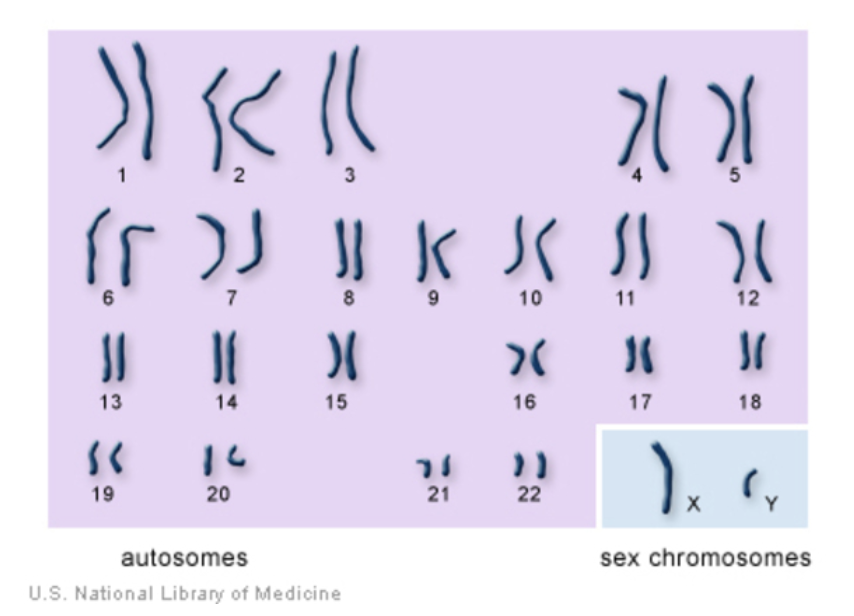The Hingerty Matrix
Using the power of atDNA to answer the Big Hingerty questions:
* Are all Hingertys related?
* How are they related?
Paper documents alone will not answer these two BIG Hingerty questions, therefore we need to turn to DNA evidence.....the exciting possibilities offered by YDNA have been discussed in previous posts.... in this post we will turn our attention to autosomal DNA.
atDNA:
Autosomal DNA is passed down through both male and female lines.
There are 22 pairs of chromosomes 1 through to 22, numbered in order of size.
(The 23rd chromosomes are the sex chromosomes X and Y. They will not be discussed in this post)
We receive one of each pair of chromosomes from our mother and the other from our father. What we receive for our parents are a mixture, re-combination from their pair. So even siblings receive a slightly different mixture from the same parents.
Recombination occurs at each generation. We inherit 50% of our atDNA from each of our parents, roughly 25% from each of our 4 grandparents, 16% from each of our great grandparents and so on.
 |
| Roberta Estes DNA Explained |
Thus it is best to test members of the oldest living generation as a matter of priority as they are closer to the distant forebears.
Which 'bits' we receive from our forebears is random and thus siblings will have a different combination of the 'bits' and thus will match some distant cousins and not others.
Therefore, a distant cousin may be related by pedigree but does not share DA with you- they are still your cousin, you just don't share any DNA.
Maybe they will match your sibling, your aunt or your cousin....which is why it is a good idea to test as many family members as possible in order to connect with more distant cousins.
The more atDNA we share with a match, the closer the relationship.
A tester will have a 100% chance of matching a parent. sibling, first cousin, grandparent, aunt/uncle and second cousin.
Once you move beyond second cousin the likelihood of matching cousins declines.
Summary:
The connections between the existing Hingerty family lines in Ireland, England, Australia and the USA will be back in the early 1800s and 1700s.
Therefore, in order to find these connections between the surviving Hingerty lines, we need to:
a) Test the oldest living generation on each line as they are closer to the generation where the connections across the lines will be.
b) Test as many Hingerty descendants as possible, since, if there are enough testers there is a greater chance that any two testers will share some DNA and thus provide evidence of a relationship.
Hingerty atDNA Matrix:
As a preliminary exercise, a few months ago, a group of Hingerty descendants from Australia, USA and Stafford who had tested at Ancestry or FTDNA were identified, contacted and shared match sizes and a matrix showing how they matched (or didn't match each other) was produced.
Note: if two testers matched within their group, the square was coloured; if two testers matched ACROSS groups then the size of the match was noted.
Many thanks to the Hingerty relations who shared their data to allow the matrix to be produced.
This very rudimentary matrix indicated that:
There is preliminary autosomal DNA evidence to show a connection between :
1. The descendants of Michael Richard Hingerty (Stafford) and John Hingerty (Australia),
2. The descendants of Mary Hingerty (Australia) and John Hingerty (Australia),
3. The descendants of William Hingerty of USA and Mary Hingerty (Australia).
The Future:
In order to progress/grow the Hingerty matrix a Hingerty All Others DNA Project has been set up at FTDNA.com to compliment the Hingerty YDNA Project already established and to make use of the analysis tools available at FTDNA (and not available elsewhere).
How can you contribute?
If you are a Hingerty descendant (male or female) and
If you have had a DNA test at FTDNA, log in and join the Hingerty All Others project.
If you have tested at Ancestry- use the instructions in this link to take a copy of your raw data and upload it to FTDNA and then join the project.
If you haven't had a DNA test yet- order one from Ancestry.com today- take the test and when you receive your results follow the link above to download your raw data and upload to FTDNA and join the Project.
(You could test directly with FTDNA, but since Ancestry has the largest data base of matches you will get more 'bang for your buck' by testing first at Ancestry then uploading to FTDNA- which has a smaller data base of matches but better tools for analysing large match groups)
We will need all the Hingerty testers we can get to help prove the connections between the various family lines!
Please don't hesitate to make contact if you have any questions or need any assistance.
Test and join today!
Leave a Comment or Send an Email
hingerty@one-name.org








Comments
Post a Comment